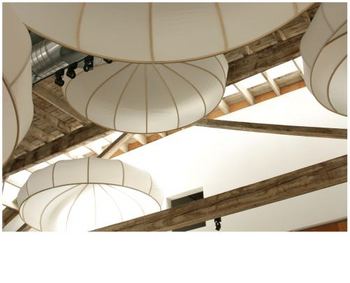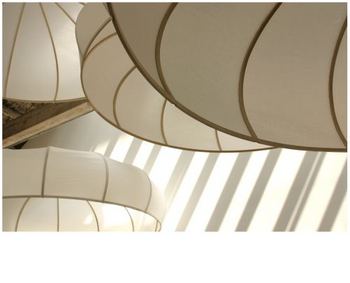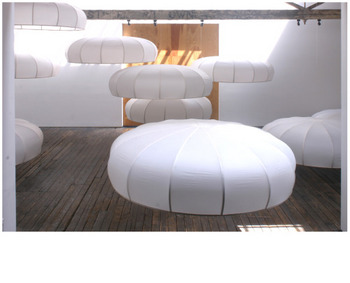Making is thinking. When the conclusions of the process are shown, it’s thinking aloud.
Andreas Bee considers the meaning of shelter at Suyama Space. (Beth Sellars curator. Through Aug. 14)
 His floating sculptures on thin, bendable wooden-strip supports resemble hats, umbrellas, clouds or pup tents. They are shelters deprived of function, as there is no sky in a gallery and no need for protection against the elements.
His floating sculptures on thin, bendable wooden-strip supports resemble hats, umbrellas, clouds or pup tents. They are shelters deprived of function, as there is no sky in a gallery and no need for protection against the elements.
 They are intrusions that slid into space with the grace of a ballet dancer pretending to be a butler. The audience is free to wander where it wants, but everywhere it goes, it is in relation to the structures hanging high or low throughout the expanse. When people stand under one, they perceive themselves wearing light like a shawl. Those on the outside see those inside as torsos with stylized cloud heads. At the opening, it was hard to keep talking. Instead, attention gravitated toward Bee’s wordless thought bubbles, how they slowly swayed in the room’s air currents, took up all the space without dominating it and served as advocates for the Herman Meville school of art, promulgated in 1851 in Moby Dick:
They are intrusions that slid into space with the grace of a ballet dancer pretending to be a butler. The audience is free to wander where it wants, but everywhere it goes, it is in relation to the structures hanging high or low throughout the expanse. When people stand under one, they perceive themselves wearing light like a shawl. Those on the outside see those inside as torsos with stylized cloud heads. At the opening, it was hard to keep talking. Instead, attention gravitated toward Bee’s wordless thought bubbles, how they slowly swayed in the room’s air currents, took up all the space without dominating it and served as advocates for the Herman Meville school of art, promulgated in 1851 in Moby Dick:
Do not reflect, compare, analyze, possess, but flow in and through, endlessly, like music.
 Martin Puryear is a member of the Melville School, which advocates thinking without words, through materials. In their myriad-minded manifestations, so are Robert Irwin and Cris Bruch. For starters.
Martin Puryear is a member of the Melville School, which advocates thinking without words, through materials. In their myriad-minded manifestations, so are Robert Irwin and Cris Bruch. For starters.



I like this idea of clarity through materials. That it speaks volumes enough for the viewer to gain their own story. Perhaps they gain access to the artist’s story, but it’s not necessary. This is the template for my own work- in fact I’m more interested in everyone else’s story about it than my own.